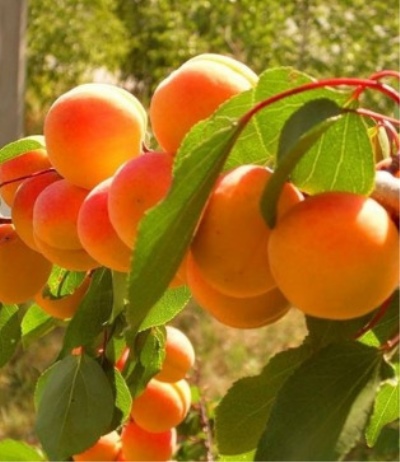
- Tree height, m: up to 5
- Fruit weight, g: 40-50
- Fruit shape: oval
- Skin : slightly pubescent, thin
- Fruit color: orange with a reddish blurred blush
- Pulp color : Orange
- Pulp (consistency): medium density, juicy
- Fruit taste: sweet, dessert
- Bone size: medium
- Separability of the bone from the pulp: good
Lovers of apricot crops are trying to plant the most delicious, unpretentious and fruitful varieties on the site. These include the mid-season Caesar variety, which is absolutely not capricious, tolerates cold well, and gives high yields annually.
Description of the variety
Caesar is a medium-sized tree with a neat raised, rounded crown. The tree is characterized by strong branching, moderate thickening with bright green foliage and a developed rhizome. A feature of the tree is the flexible shoots of a reddish hue. In favorable conditions, the fruit crop grows up to 4-5 meters in height.
The tree blooms early - in the first half of May. At this time, the compact crown is densely covered with large flowers of light pink color, which attract insects with their sweet aroma.
Fruit characteristics
Caesar is a large-fruited variety. On an adult tree, fruits weighing 40-50 grams ripen. Apricots have an oval shape, a velvety surface with a slight pubescence. Ripe fruits are endowed with an appetizing color - the orange cover is diluted with a blurred reddish blush. The peel of the apricot is thin, elastic.
Caesar apricots are ideal for canning, freezing, processing into jams, compotes, preserves, marmalades, sauces, and they are also incredibly tasty fresh. Due to the density of the pulp and the strength of the peel, the fruits tolerate transportation well, and can also be stored for a long time.
Taste qualities
This variety is famous for its excellent taste. The orange pulp of the fruit has a fleshy, firm, slightly fibrous, tender and juicy texture. The fruit has a harmonious taste - summer sweetness is perfectly complemented by refreshing notes and a bright dessert aroma. Medium-sized pits are easily separated from the apricot pulp.
Ripening and fruiting
Apricot belongs to the class of varieties with medium ripening periods. The tree begins to bear the harvest in the 3-4th year after planting. You can evaluate the first fruits in the middle of summer, and mass ripening begins in late July - early August. Due to weather conditions, fruiting times may be shifted by 1-2 weeks. Fruiting at the tree is stable - every year. The fruits are kept on a shortened and dense stalk, without crumbling.

Yield
The tree has acceptable yields. If you provide the apricot with proper care, it will certainly reward you with a good and tasty harvest. On average, 25-40 kg of fruit can be removed from one tree. In the first year of fruiting, the harvest can be modest, which is inherent in almost all fruit crops - 5-8 kg of fruit.
Self-fertility and the need for pollinators
Apricot is self-pollinated, so it is not necessary to plant donor trees, but, according to experienced gardeners, they contribute to additional cross-pollination, due to which the yield rate increases by a quarter. Apricots with similar flowering times are suitable for cross-pollination.
Growing and care
It is better to plant an apricot seedling in early spring (second half of April), when the threat of return spring frosts has passed. The best survival rate is characterized by one-two-year-old seedlings with a developed rhizome and a stem height of 110-120 cm.
The agricultural technology of a fruit tree consists of basic procedures - moderate watering, especially during dry periods, applying fertilizers three times per season, loosening and weeding the near-stem zone, crown formation, sanitary removal of dry branches, prevention of diseases and pest attacks, preparation for cold weather.



Disease and pest resistance
The species has a strong innate immunity, which helps the tree to resist many viruses and bacteria.

Winter hardiness and the need for shelter
The apricot tree has high frost resistance, so it is not afraid of temperatures of -40 ... 45 degrees. Flower buds are also hardy, practically do not crumble. The tree does not need shelter; only young trees and seedlings are recommended to be protected from frost. Before the shelter, the soil is well mulched, and then the stem and lower branches are wrapped in burlap.
Location and soil requirements
Fruit culture Caesar loves the sun, light, air, tolerates prolonged drought well. It is recommended to choose a plot for a tree even, perhaps on a small hill, most importantly, not in lowlands, where a lot of moisture accumulates, which has a detrimental effect on the root system. The site should be sunny, light, spacious, and fences are needed to protect against drafts and cold winds. It is comfortable for apricot to grow on fertile, fluffy, breathable and moderately moist soils with a neutral acidity level. These are loamy, chernozemic or soddy-podzolic soils. In addition, the groundwater must be deep - 2-2.5 meters.































































